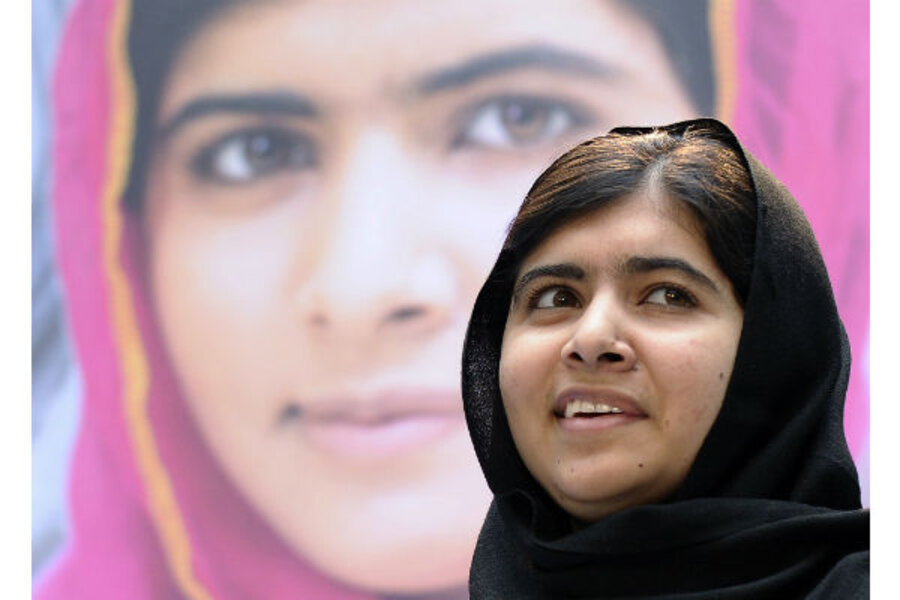Five things kids can learn from 2014 Nobel Peace Prize winners Malala Yousafzai and Kailash Satyarthi
Loading...
Friday morning the Nobel Peace Prize was awarded to Pakistani Malala Yousafzai and Indian Kailash Satyarthi, two individuals that are key forces in ending the oppression of children worldwide.
It takes teamwork to make peace work. Children learn this lesson early, perhaps when a parent or teacher gently reminds two kids warring over a toy that they need to share.
On a global scale, the same simple principle applies.
What is striking about this pairing is the number of differences between the two recipients. It offers a great model for young adults focused on building peace – in their neighborhood, city, or around the globe – and a reminder that partners in peace can come from all different background.
The Norwegian Nobel Committee said they chose Kailash Satyarthi and Malala Yousafzai ...
... for their struggle against the suppression of children and young people and for the right of all children to education. Children must go to school and not be financially exploited. In the poor countries of the world, 60% of the present population is under 25 years of age. It is a prerequisite for peaceful global development that the rights of children and young people be respected. In conflict-ridden areas in particular, the violation of children leads to the continuation of violence from generation to generation.
Showing great personal courage, Kailash Satyarthi, maintaining Gandhi’s tradition, has headed various forms of protests and demonstrations, all peaceful, focusing on the grave exploitation of children for financial gain. He has also contributed to the development of important international conventions on children’s rights.
Despite her youth, Malala Yousafzay has already fought for several years for the right of girls to education, and has shown by example that children and young people, too, can contribute to improving their own situations. This she has done under the most dangerous circumstances. Through her heroic struggle she has become a leading spokesperson for girls’ rights to education.
Here are five reasons future Nobel winners should recognize this pairing as particularly powerful.
Teen and adult, woman and man
While Ms. Yousafzai is 17, and Mr. Satyarthi is 60, both have shown that work to end oppression can happen at any age. Yousafzai was shot by Taliban militants when she was 14-years-old, as she campaigned for the right for girls to be educated.
Satyarthi has spent decades, since he was in his 20s, battling for the rights of child laborers, and also against the practice of “female feticide” also known as selective abortions of females in India.
Professional and student
According to a Wall Street Journal profile, Satyarthi was originally an electrical engineer until he started Bachpan Bachao Andolan, also known as the Save The Childhood movement. The organization is now considered a leader in the movement to eliminate child trafficking and child labor in Southeast Asia.
Yousafzai has become recognized by teenagers worldwide, and she recently made headlines for her efforts to secure the return of 200 missing Nigerian schoolgirls taken hostage by militant Islamic group Boko Haram. In a hat tip to the social generation, the hashtag #strongerthan was introduced on Malala Day 2014 (celebrated on Yousafzai’s birthday, July 14) to spread the message that peace and equality are stronger than hate.
Hindu and Muslim, Indian and Pakistani
From the announcement:
The Nobel Committee regards it as an important point for a Hindu and a Muslim, an Indian and a Pakistani, to join in a common struggle for education and against extremism. Many other individuals and institutions in the international community have also contributed. It has been calculated that there are 168 million child labourers around the world today. In 2000 the figure was 78 million higher. The world has come closer to the goal of eliminating child labour.
The Nobel announcement also highlighted a couple important distinctions, including that Yousafzai is Muslim from Pakistan, while Satyarthi is Hindu and from India. The winner's home countries are regularly at odds for political reasons, often with religious undertones, and even as the winners were announced there were reports of new nuclear threats between the two. But both countries battle very similar social problems, especially when it comes to equality of the sexes and the oppression of children. The Yousafzai and Satyarthi represent work for students and workers that transcends borders, politics, and religious difference.
Of course, with every awarding of the Nobel Peace Prize, it is valuable to look back on all of the past recipients, and recognize that characteristics of those aimed at achieving peace, regardless of race, ethnicity, religion, or nationality.
And for those who want to get involved in the peace process right away, the organization PeaceJam, started by musician Ivan Suvanjieff, partners Nobel Peace laureates with students to help facilitate social change.
While your children might still be in the phase of learning to share their toys, you might start talking with them about these models of peace now. You never know where it may lead.








